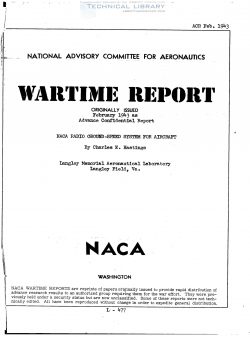naca-wr-l-477
- Version
- 137 Downloads
- 1.35 MB File Size
- 1 File Count
- April 2, 2017 Create Date
- April 2, 2017 Last Updated
NACA Radio Ground Speed System for Aircraft

SUHHARY
A method that utilises the Doppler effect on radio
signals for determining the speed of an airplane and the
distance traveled by the airplane has been developed and
found to operate satisfactorily. In this method. called
the NAGA radio ground—speed system, standard readily avail—
able radio equipment is used almost exclusively and ex—
treme frequency stabil-ity of the transmitters is not neces—
sar_y. No complicated equipment need be carried in the
airplane, as the standard radio transmitter is usually
adequate.
Actual flight tests were made in which the method was
used and the results were consistent with calibrated air;
speed indications and stop-watch measurements. Inasmuch
as the fundamental accuracy of the radio method is far
better than either of the checking systems used, no check
was made on the limitations of the accuracy.
INTRODUCTION
A number of different systems can be used to measure
the speed of an airplane and the distance the airplane
travels by the use of Doppler effect on radio signals;
but the greater number of the systems are either inaccu—
rate or difficult to use, except at exceedingly high
speeds. The most obvious method of measuring speed, for
example, is to use a frequency meter to measure the change
in frequency due to Doppler effect as the distance is
varied between the transmitter and the frequency meter.
This system requires a frequency meter of extreme sensi—
tivity and a transmitter with unusual stability. Such
transmitters and-frequency meters have not been developed.
An improvement. which is still not satisfactory for
accurate measurements at normal speeds — that is, speeds
less than 750 miles per hour — is to measure the beat fre—
quency between the moving transmitter and a similar trans-
mitter at either station when the distance is varied between
the two transmitters.' The'required frequency stability
would still be unreasonable for accurate work.
Another system is to measure the apparent beat frequen-
cy in the airplane, which is moving between two synchronised
transmitters. This system has several disadvantages that
would make it difficult to use. Complicated equipment to
synchronize the transmitters is required. and the telephone
line used to synchronize the stations has to be extremely
free from noise. A small amount of distortion results in a
phase shift or even a swing of several cycles per second in
the frequency of one transmitter. This effect is due to
the fact that the synchronizing frequency transmitted over
the telephone line is multiplied many times to obtain the
radio frequency. The measuring equipment has to be in the
moving object, which is an adVantage for some uses, but
for aircraft research work it is usually more convenient
to have the measuring equipment on the ground.
A fourth system consists in transmitting a signal from
one station and receiving this signal in a second station,
dividing this frequency by a suitable multivibrator, and
retransmitting the resulting signal to the original source.
The returned signal is then multiplied and compared with
the original signal. The beat between the two signals is
proportional to the velocity of one station With respect
to the other. This system can be operated either by send—
ing the signal from an airplane to the ground and having
a harmonically related signal sent back to the airplane
for speed determination in the airplane or by sending the
signal to the airplane from the ground and having a har—
monically related signal sent back to the ground. This
system is complicated and involves sending and receiving
harmonically related signals without feedback or blocking
of the receiver.
another system is to measure speeds by picking up
signals reflect_ed from th_e airplane itself, which in this
case needs no transmitter, and comparing these signals
with the originally transmitted signals.. This measure—
ment probably can be made with radar type of equipment if
it is available.
The system that appears m'ost satisfactory for the
present purposes and that is believed to be original is
described' in the following section. In this method,
called the HAGA radio ground—speed system, standard read—
ily available radio equipment is used almost-exclusively
and extreme frequency stability of the transmitters is
not necessary. Ho complicated equipment need be carried
MT!
in the airplane. as the standard radio transmitter is
usually adequate. This system has been adapted to the
| File | Action |
|---|---|
| naca-wr-l-477 NACA Radio Ground Speed System for Aircraft.pdf | Download |

Comment On This Post